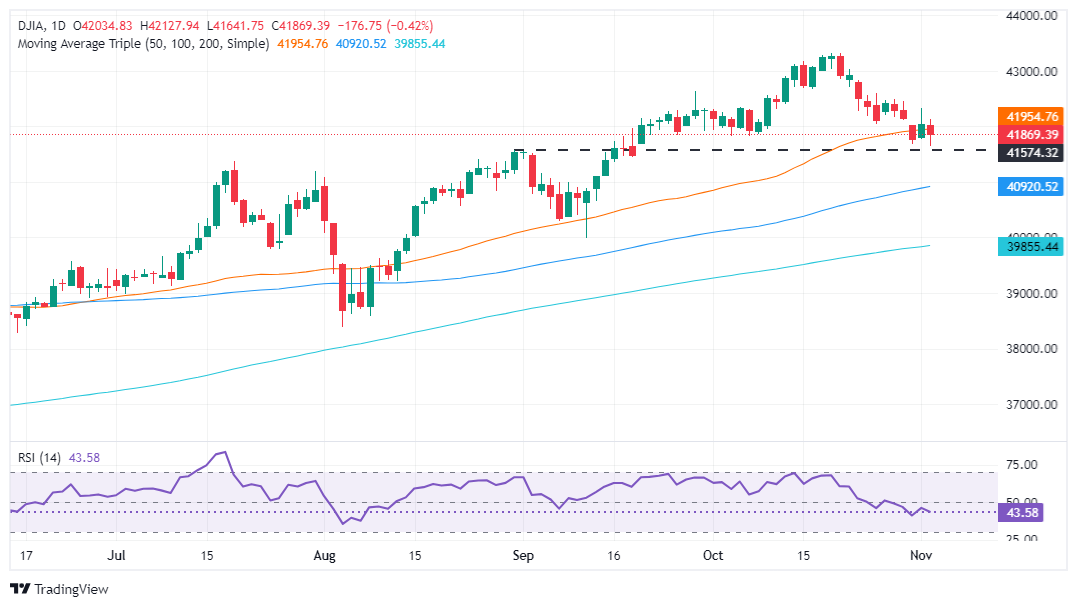- Poll volatility keeps Wall Street cautious; VIX rises above 20.
- Nvidia to replace Intel, Sherwin-Williams to replace Dow in DJIA on November 8.
- Factory Orders drop more than expected.
The Dow Jones Industrial Average (DJIA) fell over 0.29% or 100 points in early trading during the North American session on Monday. The financial markets are expected to remain volatile this week as the US presidential election remains a tight race, and swings in the polls on Monday and Tuesday could spur volatility.
Elections in the United States are driving price action in the financial markets. Recent polls suggest that Democrat Vice President Kamala Harris and Republican former President Donald Trump are in a very close race to occupy the White House from 2024 to 2028. Consequently, Wall Street trades in the red, while the CBOE Volatility Index (VIX) rises above 20.00, an indication of increasing jitters.
In the meantime, US Treasury yields along the belly to the long end of the curve post losses, while the Greenback, as measured by the US Dollar Index (DXY), plunges 0.47% down to 103.84.
The US Census Bureau revealed that Factory Orders in September dropped -0.5% MoM, more than estimates of a -0.4% shrinkage but improved compared to August’s -0.8% contraction. The US election and Thursday’s Federal Open Market Committee (FOMC) monetary policy decision overshadowed the data. The FOMC is expected to lower rates by 25 basis points (bps), and it will be followed by a press conference by Federal Reserve (Fed) Chair Jerome Powell.
The CME FedWatch Tool shows odds for a 25 bps rate cut by the Fed reaching 98%. This would leave rates in the 4.50%-4.75% range.
In addition to the above-mentioned events, the US economic docket will be busy with the release of the Balance of Trade, S&P and ISM Services PMIs, Initial Jobless Claims, and the University of Michigan (UoM) Consumer Sentiment.
Dow Jones news
In breaking news, Nvidia (NVDA) will replace Intel (INTC) in the Dow Jones. Index owner S&P writes, this change would “ensure a more representative exposure to the semiconductors industry.” In the same statement, S&P Dow Jones announced that Sherwin Williams (SHW) would replace Dow (DOW) in the materials sector. S&P revealed that the changes would be effective before the opening on Friday, November 8.
After the news broke, NVDA shares rose by 2%, while INTC tumbled over 4%. Shares of SHW jumped over 4% on news.
The Dow Jones stocks leading the pack are Home Depot (HD), which gained 0.50% to $394.55, followed by Boeing (BA), which was up 0.25% at $154.98, and Walmart (WMT), up a minimal 0.17% at $82.33. The main losers amid a dismal session for the DJIA were Intel, which was down 4.33% at $22.20, Dow, which lost 2.75% at $47.63, and UnitedHealth Group (UNH), which was down 1.66% at $558.15.
Dow Jones price forecast
The Dow Jones Industrial Average has fallen below the 42,000 threshold after hitting a two-day peak of 42,328. On its way down, the DJIA surpassed the 50-day Simple Moving Average (SMA) at 41,953, opening the door for further downside.
If the Dow Jones achieves a daily close below 42,000, sellers could push the index toward the August 30 high turned support at 41,574. On further weakness, the next stop would be the September 2 high turned support at 41,564, ahead of the 41,000 area.
If the Dow Jones posts a daily close above 42,000 buyers, it could remain hopeful of challenging the October 30 low, which turned resistance at 42,122. Once cleared, the next stop would be the October 31 high 42,460. On further strength, 42,500 could be reached before testing 43,000.
Oscillators point downward with the Relative Strength Index (RSI) preparing to push deeper into bearish territory but with enough room before turning oversold. Therefore, the DJIA path of least resistance is tilted to the downside.
Dow Jones daily chart
Dow Jones FAQs
The Dow Jones Industrial Average, one of the oldest stock market indices in the world, is compiled of the 30 most traded stocks in the US. The index is price-weighted rather than weighted by capitalization. It is calculated by summing the prices of the constituent stocks and dividing them by a factor, currently 0.152. The index was founded by Charles Dow, who also founded the Wall Street Journal. In later years it has been criticized for not being broadly representative enough because it only tracks 30 conglomerates, unlike broader indices such as the S&P 500.
Many different factors drive the Dow Jones Industrial Average (DJIA). The aggregate performance of the component companies revealed in quarterly company earnings reports is the main one. US and global macroeconomic data also contributes as it impacts on investor sentiment. The level of interest rates, set by the Federal Reserve (Fed), also influences the DJIA as it affects the cost of credit, on which many corporations are heavily reliant. Therefore, inflation can be a major driver as well as other metrics which impact the Fed decisions.
Dow Theory is a method for identifying the primary trend of the stock market developed by Charles Dow. A key step is to compare the direction of the Dow Jones Industrial Average (DJIA) and the Dow Jones Transportation Average (DJTA) and only follow trends where both are moving in the same direction. Volume is a confirmatory criteria. The theory uses elements of peak and trough analysis. Dow’s theory posits three trend phases: accumulation, when smart money starts buying or selling; public participation, when the wider public joins in; and distribution, when the smart money exits.
There are a number of ways to trade the DJIA. One is to use ETFs which allow investors to trade the DJIA as a single security, rather than having to buy shares in all 30 constituent companies. A leading example is the SPDR Dow Jones Industrial Average ETF (DIA). DJIA futures contracts enable traders to speculate on the future value of the index and Options provide the right, but not the obligation, to buy or sell the index at a predetermined price in the future. Mutual funds enable investors to buy a share of a diversified portfolio of DJIA stocks thus providing exposure to the overall index.
Information on these pages contains forward-looking statements that involve risks and uncertainties. Markets and instruments profiled on this page are for informational purposes only and should not in any way come across as a recommendation to buy or sell in these assets. You should do your own thorough research before making any investment decisions. FXStreet does not in any way guarantee that this information is free from mistakes, errors, or material misstatements. It also does not guarantee that this information is of a timely nature. Investing in Open Markets involves a great deal of risk, including the loss of all or a portion of your investment, as well as emotional distress. All risks, losses and costs associated with investing, including total loss of principal, are your responsibility. The views and opinions expressed in this article are those of the authors and do not necessarily reflect the official policy or position of FXStreet nor its advertisers. The author will not be held responsible for information that is found at the end of links posted on this page.
If not otherwise explicitly mentioned in the body of the article, at the time of writing, the author has no position in any stock mentioned in this article and no business relationship with any company mentioned. The author has not received compensation for writing this article, other than from FXStreet.
FXStreet and the author do not provide personalized recommendations. The author makes no representations as to the accuracy, completeness, or suitability of this information. FXStreet and the author will not be liable for any errors, omissions or any losses, injuries or damages arising from this information and its display or use. Errors and omissions excepted.
The author and FXStreet are not registered investment advisors and nothing in this article is intended to be investment advice.
Recommended content
Editors’ Picks

EUR/USD regains traction above 1.1000 ahead of US CPI release
EUR/USD has found fresh buyers and jumps above 1.1000 in the European session on Thursday. The pair gains on the German coalition deal and Trump's 90-day pause on reciprocal tariffs, which have lifted risk senitment while exacerbating the US Dollar pain ahead of the US CPI data release.

GBP/USD trades firm above 1.2850, US CPI data awaited
GBP/USD sustains the rebound above 1.2850 in European trading hours on Thursday. The British Pound capitalizes on risk appetite, courtesy of Trump's tariff pause, allowing the pair to recover ground. But further upside hinges on the US CPI data and US-Sino trade updates.

Gold price eases from weekly top amid risk-on mood; still well bid above $3,100 ahead of US CPI
Gold price trims a part of its strong intraday gains to a one-week high touched during the early European session on Thursday and currently trades just above the $3,100 mark. Concerns about escalating US-China trade tensions, along with fears about a tariffs-driven economic slowdown, turn out to be key factors that continue to underpin the safe-haven bullion.

US CPI data set to reveal March inflation dip as markets weigh impact of Trump’s tariffs
As measured by the CPI, inflation in the US is set to rise at an annual pace of 2.6% in March, down slightly from the 2.8% reported in February. Core CPI inflation, which excludes the volatile food and energy categories, is expected to ease to 3% in the same period from a year earlier

Trump’s tariff pause sparks rally – What comes next?
Markets staged a dramatic reversal Wednesday, led by a 12% surge in the Nasdaq and strong gains across major indices, following President Trump’s unexpected decision to pause tariff escalation for non-retaliating trade partners.

The Best brokers to trade EUR/USD
SPONSORED Discover the top brokers for trading EUR/USD in 2025. Our list features brokers with competitive spreads, fast execution, and powerful platforms. Whether you're a beginner or an expert, find the right partner to navigate the dynamic Forex market.




